Singapore – Word-of-mouth and genuine love for a brand continue to be one of the most powerful sources of brand promotion and marketing, and this is on top of micro-marketers or online influencers, who, even though arguably relatable, still patronize brands under a sponsorship or a deal. We go much deeper into the user-generated brand love phenomenon – and that is through our close network on social media. With less outside influence, and trust that laden with more truthful opinion, word-of-mouth is now digitized online buzz.
Asia-Pacific is a region with strong collective values and beliefs and when it comes to well-loved brands on social media, consumers bound by this region seem to gravitate the same towards conversations on the same types of brands.
According to a quarterly study by Digimind, a social listening and market intelligence platform, the top most discussed brands for the second quarter of the year have taken up quite a lot of changes since the previous quarter.
The study notes why consumers, more than experiencing brands, love to ‘talk’ about them on social media – it’s because the simple act of it has become some kind of self-actualization.
“There is a gratifying feeling to express how they feel about a product or service, or simply have an opinion,” notes the study.

For starters, the title of the most-discussed brand in APAC has been retained from the first quarter of the year, and it is none other than Singapore-born e-commerce platform Shopee. A lot of brands have fluctuated among consumers’ radar, but not Shopee, which isn’t surprising.

E-commerce has been the go-to shopping ‘destination’ for most since a brunt of physical establishments has been, for the meantime, closed down. With almost everyone accomplishing their purchases on e-commerce platforms such as Shopee, similarly Singaporean platform Lazada, and Indonesia’s Tokopedia, the next impulsive step is to share them on social media and boast of them, as doing so enables consumers to feel an even greater sense of elation and self-worth.
This has been evident with the latter, with Lazada pushed two places up from Q1, and then Tokopedia an inch closer from the previous period, for both to enter in the top 10 most discussed brands.
Meanwhile, the holy grail brands and platforms that are at consumers’ immediate disposal, continue to dominate conversations on social media. These are Spotify, Google, Netflix, Apple, and Zoom, with all falling under the top 10 most discussed.
Massive celebrity collaborations have also made way for consumers’ interest to be supercharged towards certain brands, and we’re speaking specifically of the global stardom of K-pop group BTS, which has amplified brand love for McDonald’s and even luxury brand Louis Vuitton.
The study notes that while much of the commotion is directly from its passionate fan base, a part of the social buzz is also affected by those whose curiosity has been stirred, and therefore, channeling their recent ‘discoveries’ on social media as well.
With McDonald’s releasing the ‘BTS meal’ across its global markets, the fast-food label jumped to the top 10 of the APAC rankings in Q2 by 34 places.
Meanwhile, global fashion brand Louis Vuitton which has recently ridden the BTS bandwagon, allowed for it to amass significant social buzz within a relatively short frame of time, putting them within the top 20 rankings by an upturn of 32 spots.
Another more surprising movement in social buzz based on the study is one with TikTok, which from being part of the top 10, is now nowhere in sight of the top 50. Maybe, the short-video platform, despite its popularity, enjoys much more viewership and usage of the app itself, more than being talked about as it is from afar.

Meanwhile, popular super apps and delivery platforms in the region – Grab, foodpanda, and Gojek – which have been looked to with much more dependence from users, have all landed in the top 20.
“For brands, resonating with the right community is as good as leaving them to handle your marketing with every individual promotion helping to populate your brand’s campaign further,” noted the report.
Data presented were collected by Digimind Historical Search and based on social mentions in APAC between April to June 2021 on platforms such as Twitter, Facebook, Instagram, and even from Pinterest, Reddit, and Tumblr, and YouTube, among others.



